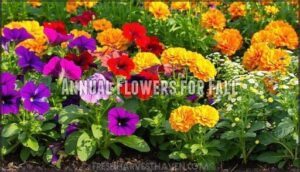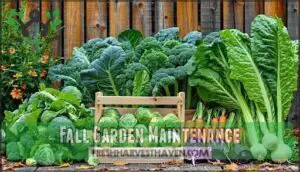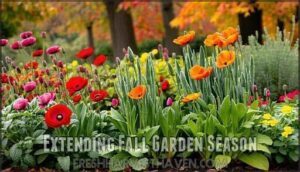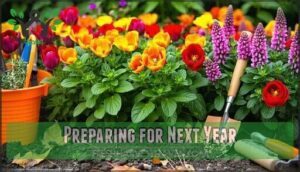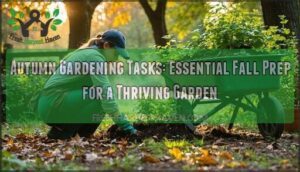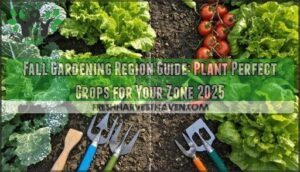This site is supported by our readers. We may earn a commission, at no cost to you, if you purchase through links.
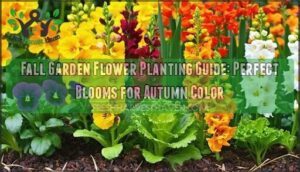 Your fall garden flower planting guide starts with timing—plant 6-8 weeks before your first hard frost hits.
Your fall garden flower planting guide starts with timing—plant 6-8 weeks before your first hard frost hits.
Cool-weather champions like pansies, snapdragons, and ornamental kale actually prefer autumn’s crisp air over summer’s scorching heat. Think of fall planting as giving your flowers a head start; they’ll establish strong roots while temperatures drop gradually.
Perennials such as asters and mums become your garden’s backbone, returning year after year with reliable blooms. The secret lies in choosing varieties that laugh in the face of chilly mornings while still producing vibrant colors through November.
Smart plant selection and proper soil preparation make all the difference in creating spectacular autumn displays.
Table Of Contents
- Key Takeaways
- Fall Garden Planning
- Fall Flower Options
- Planting Fall Gardens
- Fall Garden Maintenance
- Extending Fall Garden Season
- Preparing for Next Year
- Frequently Asked Questions (FAQs)
- . Why Should You Start Seeds indoors?
- . Which Seeds Should You Start indoors?
- . When Should You Start Seeds indoors?
- . When Should You Transplant seedlings?
- What flowers are best for fall planting?
- When should I start my fall flower garden?
- What flowers are best to plant in September?
- Can you plant a flower bed in the fall?
- When should I stop deadheading flowers for winter?
- Can fall flowers survive unexpected early frost?
- Conclusion
Key Takeaways
- Start your fall garden planning by early September, planting 6-8 weeks before your first hard frost to give flowers time to establish strong root systems while temperatures gradually drop.
- Choose cool-weather champions like mums, pansies, snapdragons, and ornamental kale that actually prefer autumn’s crisp air over summer heat and will bloom reliably through November.
- Focus on perennials such as asters and mums as your garden’s backbone since they’ll return year after year with vibrant colors, while annuals like marigolds and nasturtiums provide immediate seasonal impact.
- Prepare nutrient-rich soil with 2-3 inches of compost, ensure proper drainage, and apply mulch for winter protection to create the foundation for spectacular autumn displays that’ll thrive through changing weather conditions.
Fall Garden Planning
You’ll want to start your fall garden planning by early September, giving yourself at least eight weeks before your area’s first frost date to establish strong root systems.
Start planning your fall garden by early September—eight weeks before frost gives roots time to establish and thrive.
Focus on selecting hardy flowers like mums and asters, choosing colorful shrubs such as winterberry, and preparing nutrient-rich soil with compost to create the foundation for spectacular autumn blooms, including spectacular autumn displays.
Choosing Fall Flowers
Autumn’s flower palette demands careful selection for maximum impact.
Choose chrysanthemums for their diverse flower colors and extended bloom times, while zinnias provide vibrant hues through frost.
Consider each variety’s sunlight needs—most fall planting flowers thrive in full sun.
Match soil preferences with your garden’s conditions, creating stunning flower combinations that showcase the best fall blooms for lasting autumn beauty.
Floribunda roses are ideal for planting in the fall, offering consistent flowering from late spring to late fall, providing a consistent flowering display.
Selecting Shrubs and Trees
Strategic shrub and tree selection transforms your fall garden into a spectacular autumn showcase. Consider these essential factors when choosing woody plants for lasting fall color and year-round structure:
Your fall garden’s transformation begins with the right shrubs and trees—choose wisely for year-round beauty that evolves with every season.
- Evaluate mature shrub size – Match plant dimensions to available space, preventing overcrowding as specimens reach full growth potential.
- Prioritize tree placement – Position trees considering utility lines, foundations, and future shade patterns for ideal landscape integration.
- Select winterberries and fruit bearing varieties – These provide wildlife habitat while offering vibrant berries that persist through winter months.
Evergreen options like cypress and arborvitae provide consistent backdrop structure, while deciduous fall shrubs deliver seasonal drama.
Fall planting allows root establishment before winter dormancy, guaranteeing stronger spring growth in your fall garden. To guarantee proper growth, it’s best to test the soil pH before planting.
Preparing Soil for Fall
Good soil preparation sets your fall garden up for success.
Start with soil testing to determine pH and nutrient levels.
Apply compost application by working in 2-3 inches of organic matter for nutrient-rich soil.
Focus on drainage improvement in heavy clay areas.
These soil amendments create ideal soil conditions, while proper winter protection through mulching helps maintain soil structure throughout the season.
Fall Flower Options
You’ll find fall offers an impressive selection of flowers that actually prefer cooler temperatures, from reliable annuals like marigolds and nasturtiums to stunning perennials such as asters and mums.
These autumn bloomers won’t just survive the season’s changing conditions—they’ll thrive in them, providing vibrant colors and extended flowering periods that many summer varieties simply can’t match, with reliable annuals being a key part of this.
Annual Flowers for Fall
Annual flowers bring vibrant color to your fall garden when summer blooms fade.
Zinnia varieties like ‘State Fair Mix’ withstand cooler temperatures, while marigold care involves deadheading for continuous blooms.
Nasturtium uses include edible flowers and pest control.
Calendula benefits include frost tolerance and medicinal properties.
Rudbeckia types provide golden autumn hues.
These hardy annuals guarantee your fall flower guide delivers spectacular results.
Consider soil preparation importance for ideal root growth.
Perennial Flowers for Fall
Unlike annuals that need yearly replanting, perennial flowers return season after season, making them smart investments for your autumn garden.
Asters and mums steal the show with vibrant blooms, while rudbeckia varieties provide golden cheerfulness.
Hylotelephium care remains minimal, and heliopsis benefits include extended flowering.
Don’t overlook lycoris squamigera’s surprise late-season pink blooms.
Vines for Fall Foliage
Vines transform vertical spaces into stunning fall displays.
Clematis varieties like ‘Ville de Lyon’ produce late-season blooms, while Virginia creeper (Parthenocissus quinquefolia) delivers brilliant red foliage that’ll make your neighbors jealous.
English ivy adds colorful texture, and don’t overlook winterberries for bright red accents.
These climbing beauties maximize your garden’s autumn impact effortlessly, with stunning fall displays.
Planting Fall Gardens
You’ll find fall offers the perfect window for establishing hardy bulbs, perennials, and shrubs since cooler temperatures and natural rainfall help plants develop strong root systems before winter arrives.
Start planting at least eight weeks before your first expected frost to give your new additions enough time to settle in and thrive through the colder months ahead.
Planting Hardy Bulbs
Fall bulbs are your garden’s secret weapon for spectacular spring blooms.
Choose tulips, daffodils, and crocuses for reliable flower varieties that thrive in your climate.
Plant them twice their height deep in well-draining soil before the first hard frost.
Consider buying tulip bulbs for a wider selection.
Good soil drainage prevents rot, while mulch provides winter protection for your fall garden investment, ensuring a strong start for your spectacular spring blooms.
Planting Perennials and Shrubs
When selecting perennials and shrubs for your fall garden, focus on varieties that establish quickly before frost arrives.
Choose native species adapted to your climate zone, ensuring proper spacing based on mature plant size.
Group plants with similar water and sunlight needs together.
Dig planting holes twice the root ball’s width, loosening soil to 8-12 inches deep for ideal root establishment and healthy growth.
Caring for Newly Planted Fall Gardens
Once you’ve established your new plantings, consistent fall garden maintenance becomes the key to their survival.
Your watering schedule should provide deep, infrequent drinks rather than daily sprinkles.
Here’s your fall garden preparation checklist:
- Apply 2-3 inch mulch depth around plants for root protection
- Monitor pest control weekly for common fall invaders
- Add soil amendments before ground freezes
These winterizing techniques guarantee thriving spring gardens.
Fall Garden Maintenance
Once you’ve planted your fall flowers, you’ll need to maintain them properly to guarantee they thrive through cooler temperatures and changing weather conditions.
Your autumn blooms require consistent watering, protective mulching, and vigilant pest management to deliver the vibrant colors you’re counting on all season long.
Watering and Mulching Fall Crops
Proper plant care after fall planting requires consistent attention to watering frequency and mulching strategies.
Water your fall garden deeply once or twice weekly, adjusting based on rainfall. Apply 2-3 inches of organic mulch around plants for moisture retention and weed suppression.
Quality mulch types like shredded leaves or bark provide winter protection while supporting healthy root development throughout garden maintenance season.
Remember to adjust irrigation timers to about 70-80% of summer settings, ensuring optimal moisture retention for your fall garden.
Protecting Plants From Pests and Diseases
When autumn arrives, your fall garden becomes vulnerable to lingering pests and diseases that can damage your beautiful blooms.
Pest identification and disease prevention require vigilant monitoring techniques to keep your autumn garden thriving through winter.
Essential garden pest control and plant care strategies include:
- Inspect plants weekly for early signs of insects or fungal issues
- Remove diseased foliage immediately to prevent spread throughout your garden
- Apply organic solutions like neem oil for gentle yet effective treatment
- Maintain proper spacing between plants to improve air circulation
- Clean gardening tools regularly to avoid cross-contamination between healthy plants
Effective management requires specialized pest solutions.
Supporting Plants With Row Covers
When autumn’s chill threatens your fall garden plants, row covers become your secret weapon for pest protection and temperature regulation.
Install lightweight fabric covers over hoops, securing edges with soil or clips for proper installation techniques.
These shields extend your harvest season while protecting delicate fall flowers from hungry insects.
Choose breathable materials that allow light penetration for ideal autumn garden success, ensuring your garden remains healthy with temperature regulation.
Extending Fall Garden Season
You can stretch your fall garden’s productive season well into winter by using simple protection methods and strategic plant choices.
These techniques help you enjoy fresh blooms and harvests even when temperatures drop, turning what might seem like gardening’s end into an extended growing opportunity, allowing for fresh blooms.
Using Row Covers and Cold Frames
When temperatures drop, row covers and cold frames become your fall garden’s best friends for extending the growing season.
These protective barriers shield your fall flower varieties from harsh winds and frost while maintaining ideal growing conditions.
- Row Cover Types: Choose lightweight fabric covers for mild protection or heavy-duty plastic for severe weather conditions
- Cold Frame Design: Build angled frames with glass or polycarbonate tops to trap heat and regulate temperature naturally
- Extending Harvest: Protect tender fall garden plants like nasturtiums and calendula for weeks of additional blooms
- Pest Protection: Create physical barriers that keep insects and small animals away from your fall planting investments
Bringing Plants Indoors for Winter
When nighttime temperatures consistently drop below 54°F, it’s time to relocate your fall garden plants indoors.
Start the acclimation process gradually, inspecting each plant for pest prevention before bringing them inside.
These autumn flower varieties need proper indoor lighting and humidity control during their dormancy needs phase.
Group plants together to naturally increase moisture levels around your cherished fall planting investments.
Creating a Winter Garden Landscape
While fall garden plants fade, you can create lasting winter interest through strategic design choices.
Incorporate evergreen structure with conifers and broadleaf evergreens as your backbone.
Add hardscape elements like decorative stones or trellises for visual appeal.
Plant winter interest plants with colorful bark or persistent berries that support wildlife through cold months, extending your garden’s beauty year-round.
Preparing for Next Year
As your fall garden settles into dormancy, you’ll want to take smart steps now that’ll pay off when spring arrives with its burst of growing energy.
Proper tool maintenance, perennial bed preparation, and thoughtful planning for next year’s autumn display will transform your garden from a seasonal afterthought into a well-orchestrated symphony of color and texture, with complete concepts of garden design in mind.
Cleaning and Storing Gardening Tools
Before winter’s grip tightens, proper tool cleaning methods will save you money and frustration come spring.
Remove soil and debris, then apply rust prevention tips like oil coating metal surfaces.
Safe storage practices mean hanging tools in dry spaces, while sharpening techniques keep blades keen.
Winterizing equipment through thorough autumn garden maintenance guarantees your garden tools survive harsh conditions, utilizing proper tool cleaning methods.
Preparing Perennial Gardens for Spring
After storing your tools properly, you’ll want to prep your perennial flowers for their spring comeback.
Cut back spent stems to 3-4 inches, leaving some for winter interest.
Apply a 2-3 inch mulch application around plant bases for winter protection.
Add compost as soil amendments now—your fall garden plants will thank you with vigorous growth when temperatures warm up again.
Planning Next Year’s Fall Garden
Now that your perennial beds are winter-ready, turn your attention to planning next year’s autumn garden.
Start garden journaling to track which varieties thrived and which struggled. Consider crop rotation for healthier soil and better blooms.
Begin seed saving from your best performers, and create a budget planning spreadsheet for bulbs and plants.
Remember to apply compost and mulch to nourish the soil over the winter. Test soil pH levels to determine what amendments you’ll need for ideal fall garden planning success, and ensure you have a plan for better blooms.
Frequently Asked Questions (FAQs)
. Why Should You Start Seeds indoors?
Starting seeds indoors gives you a head start on the growing season, letting you nurture delicate seedlings in controlled conditions while Mother Nature’s still unpredictable outside.
This ensures stronger plants ready for transplanting.
. Which Seeds Should You Start indoors?
You’ll want to start tender annuals like impatiens, begonias, and coleus indoors since they can’t handle frost.
These heat-loving flowers need that head start to bloom before fall’s first freeze arrives.
. When Should You Start Seeds indoors?
Though timing seems tricky, you’ll want to start fall flower seeds indoors 6-8 weeks before your first expected frost date.
This gives seedlings enough time to establish strong roots before transplanting outdoors.
. When Should You Transplant seedlings?
Transplant your seedlings outdoors when they’ve developed their second set of true leaves and nighttime temperatures consistently stay above 50°F.
This usually occurs 2-3 weeks after germination, ensuring strong root establishment.
What flowers are best for fall planting?
As autumn’s curtain falls, mums steal the spotlight with their vibrant blooms.
You’ll love nasturtiums, calendula, and pansies for their cold tolerance.
These hardy performers thrive in cooler temperatures, delivering stunning color until frost arrives.
When should I start my fall flower garden?
Start your fall flower garden about eight weeks before your area’s first expected frost.
That gives your plants enough time to root.
Picture it as a head start—like getting your coffee ready before the morning rush!
What flowers are best to plant in September?
Picture your garden as an old jukebox ready for fresh tunes—plant mums, asters, calendula, and pansies in September.
Give zinnias or rudbeckias a try too.
They’ll handle fall’s cool curtain call and keep your flower show strong.
Can you plant a flower bed in the fall?
Yes, you can absolutely plant a flower bed in fall! It’s actually ideal timing. Cool-weather flowers like mums, pansies, and asters thrive, while perennials establish strong roots before winter’s arrival.
When should I stop deadheading flowers for winter?
Stop deadheading most flowers by mid-September to let them develop seeds and prepare for winter. However, keep deadheading mums, pansies, and other fall bloomers to encourage continued flowering through autumn.
Can fall flowers survive unexpected early frost?
Many fall flowers can handle light frost surprisingly well. Hardy varieties like mums, pansies, and calendula bounce back from unexpected cold snaps, while tender annuals need protection with frost cloth.
Conclusion
Success blooms when you follow this fall garden flower planting guide with confidence and care.
You’ve learned the essential timing, plant selections, and maintenance techniques that transform ordinary autumn spaces into vibrant displays.
Remember, fall planting isn’t just about immediate beauty—you’re investing in next year’s spectacular show.
Start planning your selections now, prepare your soil properly, and watch as your garden becomes the neighborhood’s crown jewel through winter’s approach.
- https://ngb.org/wildflower-seeds-fall/
- https://www.lowes.com/n/how-to/fall-is-for-planting
- https://extension.uga.edu/publications/detail.html?number=AP105&title=fall-gardening-a-collection-of-information-and-resources
- https://stacyling.com/preparing-the-flower-garden-for-fall-plantings/
- https://www.provenwinners.com/learn/make-your-bed

